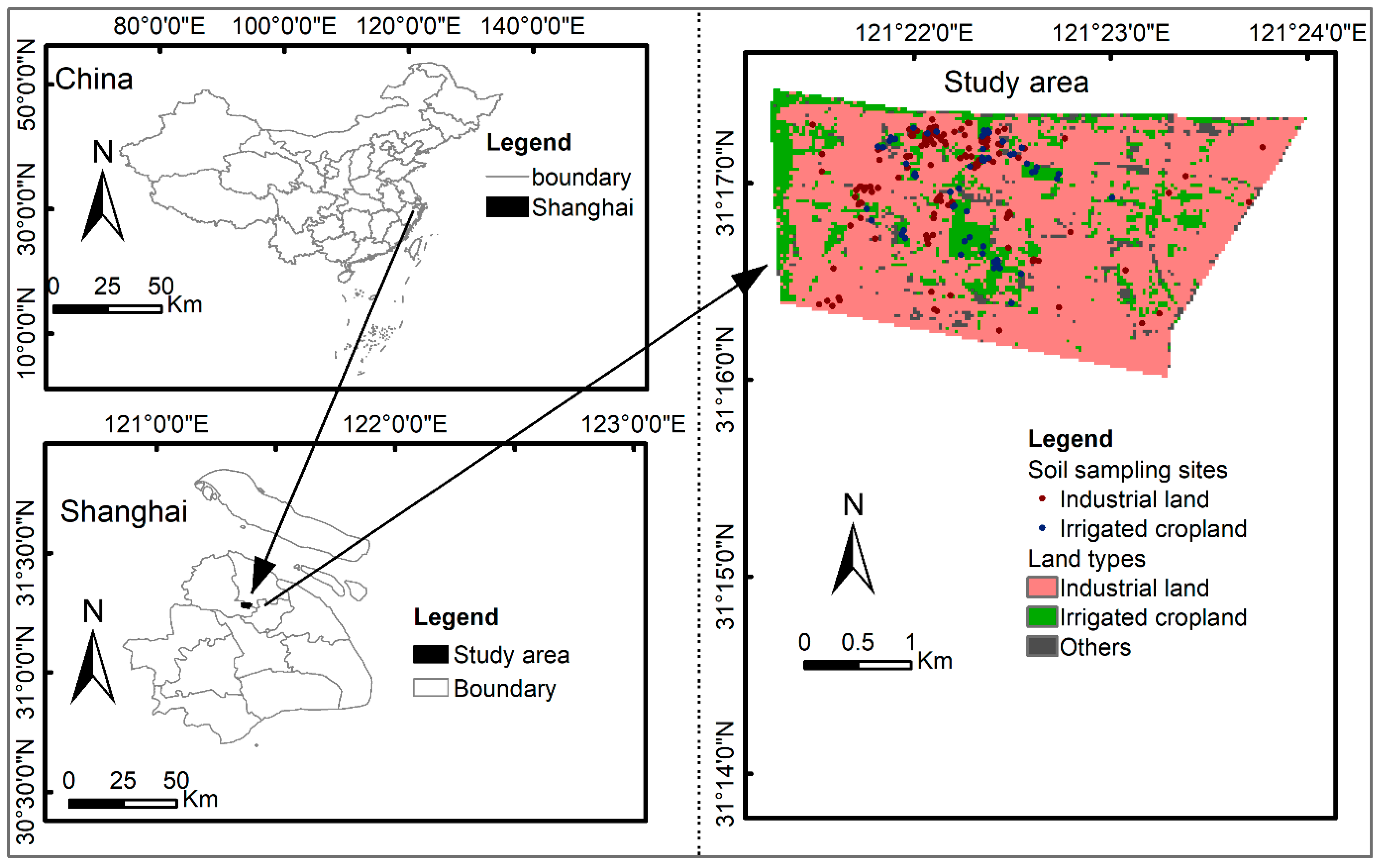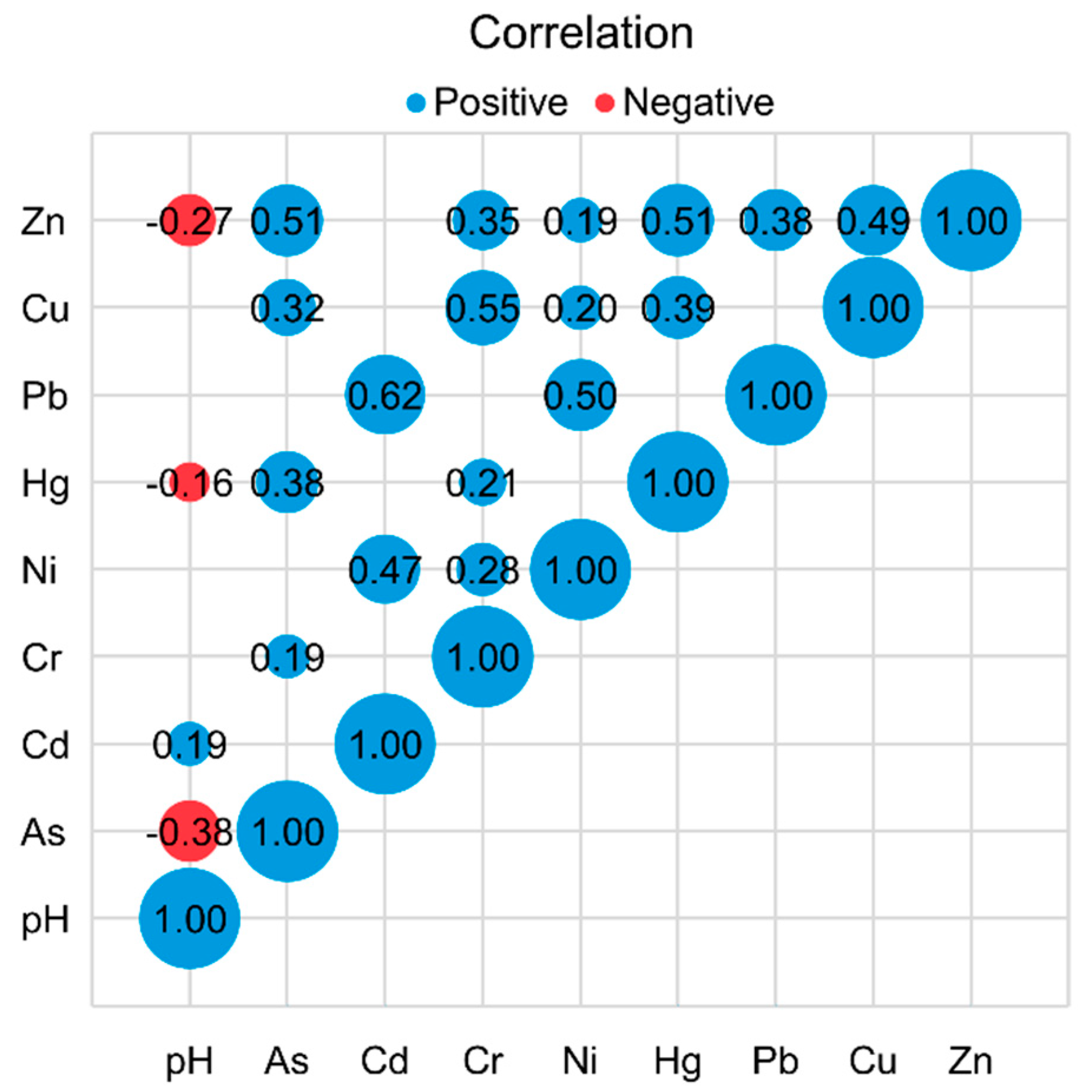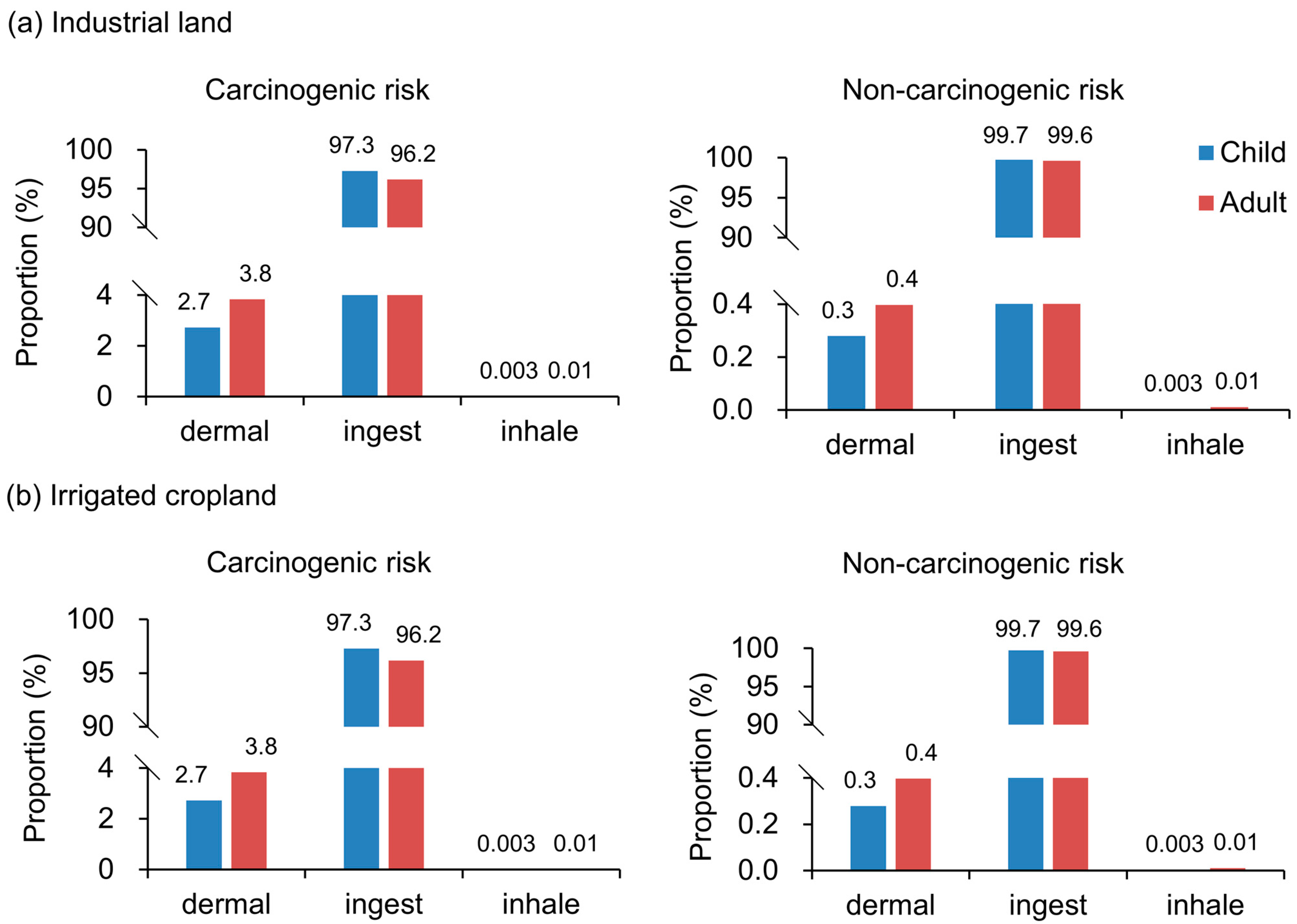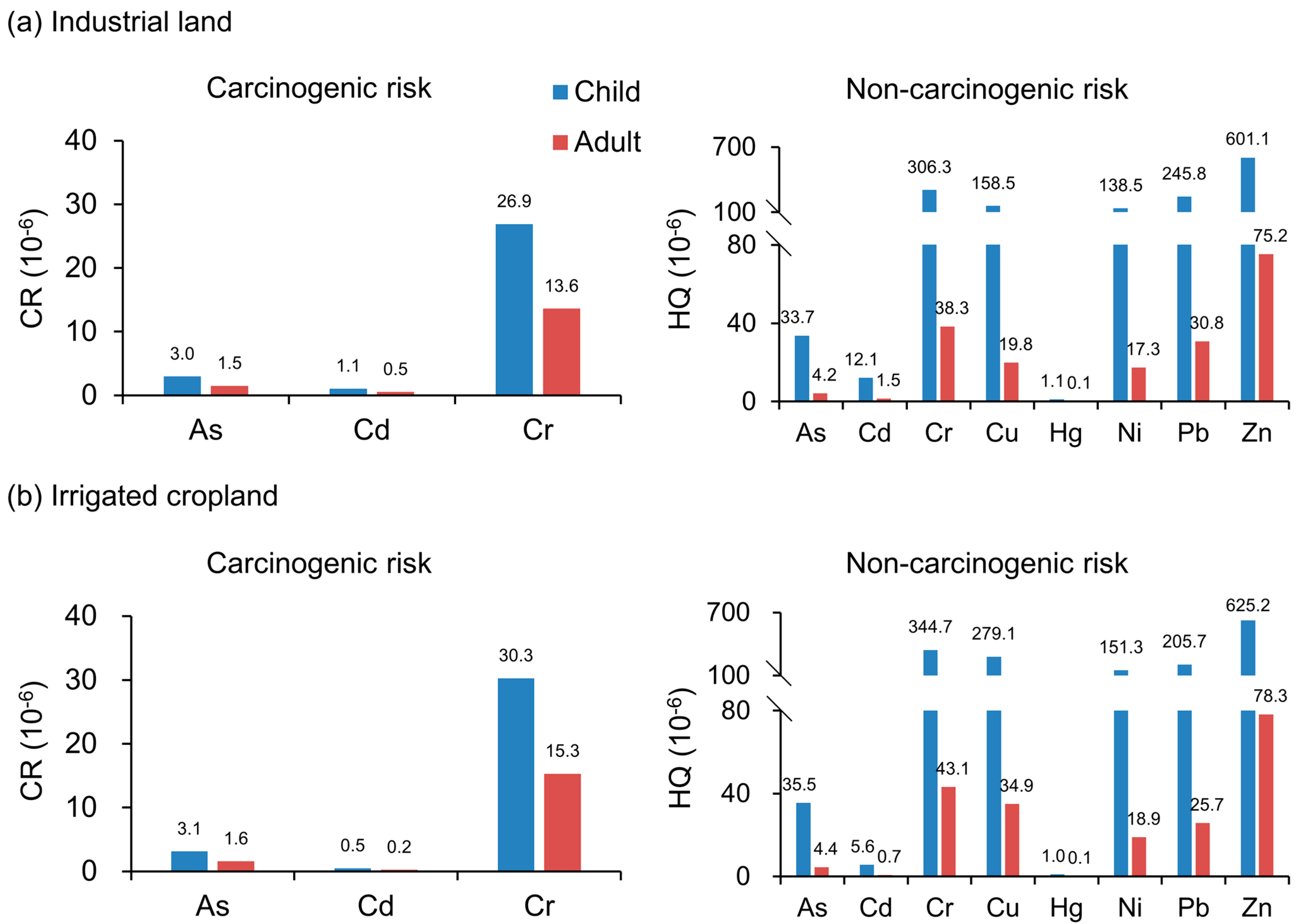1. Introduction
Heavy metal (HM) pollution in the environment mainly comes from anthropogenic activities, such as mining, the discharge of industrial waste gas and wastewater, automobile exhaust, and the utilization of pesticides and fertilizers [
1]. Heavy metals are highly toxic, long lasting, and difficult to biodegrade [
2,
3,
4]. Once these substances accumulate in the environment, they will be a severe pollutant source that threatens ecology and human health safety [
5]. For example, excessive As can cause cardiovascular diseases [
6], and excessive Cd can lead to liver disease [
7]. Pb poisoning causes 0.9 million deaths globally every year [
8]. The issue of heavy metal pollution in soil has attracted attention from the world [
9], especially in industrial areas [
10].
Heavy metal pollution under different land uses has different effects. Gupta et al. [
11] studied heavy metal pollution in agricultural land and found that the concentrations of Cd and Zn were high due to the use of pesticides and fertilizers. Peng et al. [
12] studied the health risks of heavy metals in industrial land, and found that Pb, Cd, Zn, Ni, and As had a higher risk. Yuan and Wang [
13] studied the risk of heavy metals under two land types and found that the risk of industrial land was higher. The reason why the risk of heavy metals varies under different land-use types is that the sources of pollution are different. Previous studies have focused on the pollution risk of heavy metals under specific land-use types without considering the impact of land-use change. For example, when industrial land is converted into residential land, pollution is caused by industrial emissions, but the time and frequency of exposure to residential land will increase, which will significantly amplify the health risks caused by heavy metals.
As the largest city in southern China, Shanghai has become one of the most economically developed and densely populated regions in China. Over the past few decades, many lands in Putuo have been utilized for industrial activities to promote industrial development [
14]. HMs in the soils of the Putuo industrial area have become a major pollution problem, resulting in serious land degradation, and threatening sustainable land management [
15]. To our knowledge, many previous studies in Shanghai on soil HMs have focused only on pollution evaluation, while few studies have focused on the health risk and source identification of HMs. In these directions, bi [
16] studied the impact of Pb pollution on agriculture in Shanghai’s industrial zone but did not consider the influence of land-use covers on the results of health risk assessment in soil. As, Cr, Cd, Ni, Hg, Pb, Cu, and Zn are the basic pollutants in the soil environmental standards of China, excessive amounts will cause carcinogenic and non-carcinogenic risks to human health [
17].
Previous studies on soil environmental risks in industrial areas mainly focused on the health impact on workers [
18,
19], but the exposure time and frequency of this impact cannot be compared with the impact on residential land. As an industrial output value of more than 1 trillion ¥ in 2021 [
20], Shanghai ranks first in China and is the most important industrial city. With the change in urban planning, a large number of industrial land will be converted into residential land. However, at present, few studies have considered the impact of industrial pollution on residents under this change. Therefore, this study aims at more advanced ways to determine pollution sources and human health risks of eight heavy metals in the soil of the Putuo Industrial area in Shanghai. The specific objectives of this study were as follows: (1) investigate the concentrations and spatial distribution characteristics of eight heavy metals (As, Cr, Cd, Ni, Hg, Pb, Cu, and Zn) in the soil of an industrial area, (2) analyze the differences of pollution sources under different land-use covers in soil, and (3) identify priority control pollutants and areas under different land-use covers based on health risk assessment. Understanding the health risk in industrial land offers additional information for programming and managing the limited land more effectively; it also gives a better suggestion for preventing and controlling heavy metal pollution from the sources at the same time.
2. Materials and Methods
2.1. Study Area
The study area is located in northern Shanghai city, east China (
Figure 1), with a total area of 4 km
2 (121°21′1″–121°23′44″ E, 31°15′57″–31°17′27″ N). According to the 2010 China population survey, the total population of the study area is about 8.35 × 10
4, with children accounting for 7.7% and adults accounting for 92.3%. The study area is influenced by a subtropical monsoon climate. The temperature of this region is 5.5–34.3 °C, and the average annual precipitation is 1200 mm. The main soil type in the study area is clay. At the end of the 20th century, the research area was still undeveloped and belonged to the suburbs, dominated by wasteland and farmland. At present, Shanghai, where the study area is located, is an important heavy industry base in China. There are many industrial types in the region, including sludge landfills, thermal power plants, spice plants, chemical plants, pharmaceutical plants, spice plants, ink plants, and wastewater treatment plants. Heavy metals are widespread pollutants in the industrial area of Shanghai City; moreover, the overall pollution level is increasing gradually year by year. Since the government intends to convert the land in the study area into residential land and parks, detailed pollution investigations and risk assessments are necessary.
2.2. Sampling and Testing
A total of 199 soil samples were taken from the upper soil layer (0–50 cm) in 2016. Five random sub-samples from a nearby 5 m
2 area were mingled, and 0.5 kg soil samples were collected in a polyethylene bag and then brought back to the laboratory from each sample site. For further analyses, the soil samples were air-dried naturally at room temperature, and after debris removal, they were ground in an agate mortar and passed through a 20-mesh (<0.84 mm) nylon sieve. Thereafter, the samples were further filtered using a 200-mesh (<0.074 mm) sieve. A typical concentrated acid mixture of HNO
3-HF-HClO
4 (with a volume ratio of 3:1:1, purchased from Sinopharm Chemical Reagent Inc., CO, Shanghai China) was used for the digestion of samples and stored in glass bottles. Then, we measured the heavy metal concentrations (As, Cd, Cr, Ni, Hg, Pb, Cu, and Zn) of soil samples by Inductively Coupled Plasma Mass Spectrometry (ICP-MS, Agilent 7900, Palo Alto, CA, USA). Analysis and Quality Assurance/Quality Control (QA/QC) met the requirements of the USEPA 6020B [
21].
2.3. Pollution Evaluation
The index of geo-accumulation (Igeo), originally proposed by Müller [
22], was first used to assess sediment pollution levels. It has since then been widely used to assess soil pollution status, compared with environmental background values.
CI: the concentration of metal I in the soil sample,
BI: the corresponding background value of metal i.
K was used to correct the regional differences of the soil background value (generally a constant of 1.5). The contamination degree of heavy metals was graded into seven levels (
Table 1).
2.4. Health Risk Assessment
The HMs of surface soil could enter the human body through dermal absorption, ingestion, and inhalation. Therefore, the average daily doses (ADDs) for ingestion (ADD
ing), inhalation (ADD
inh), and dermal (ADD
derm) exposure pathways (mg/kg·day) were estimated based on the USEPA method as follows (aselineHumanHealt, 2001):
The parameters used in these equations are defined in
Table 2.
The non-carcinogenic risk was estimated using a hazard quotient (HQ) for each element and a hazard index (HI) for the sum of HQ through different exposure pathways. HI and HQ were calculated as follows:
ADD: Daily intake via a certain route, mg/(kg·d);
RfD: Non-carcinogenic reference dose produced via a certain exposure route, mg/(kg·d);
HQ: Hazard quotient;
HI: Hazard index caused by different intake routes.
RfD is the reference dose (mg/kg·day), and the RfD values for each element, and different exposure pathways were obtained from the USEPA Integrated Risk Information System (IRIS).
The risk of cancer due to exposure to HMs was estimated based on Excess Lifetime Cancer Risk (CR). The CR for different exposure pathways was calculated using the following formulas:
ADD: Daily intake via a certain route, mg/(kg·d);
SF: Carcinogenic intensity coefficient, (kg·d)/mg;
CR: Carcinogenic risk via a certain exposure route;
TCR: Total carcinogenic risk via different intake routes.
According to the EPA, the reference dose (RfD), skin permeability constant (PC), and carcinogenic intensity factor (SF) of the eight heavy metals in groundwater under the two exposure routes of drinking and skin contact are shown in
Table 3.
The evaluation criteria of non-carcinogenic risk and carcinogenic risk are shown in
Table 4.
2.5. Data Analysis and Statistics
All statistical analyses were performed using Excel 2016 (Microsoft, Redmond, WA, USA). Correlation analysis and principal component analysis were performed to show the relationships between heavy metal contents and soil properties by SPSS 24.0 (IBM, Armonk, NY, USA). Kriging interpolation was applied to determine the spatial distribution of heavy metal content by ArcGIS 10.7 (ESRI, Redlands, CA, USA). In addition, we simulated 10,000 times with a Monte Carlo simulation to identify the risk probability using Crystal Ball v11.0 (Oracle, Austin, TX, USA).
4. Conclusions
This study assessed the contamination levels, sources, pollution distribution, and health risks of eight typical heavy metals in the industrial area soils of east China. Igeo showed that Cd, Hg, and Pb had the most serious pollution under the two land-use types. PCA identified the pollution sources under two land-use types: under irrigated cropland, the main sources were natural sources and traffic sources; under industrial land, the main sources were natural sources, industrial sources, and traffic sources. The health risk assessment model showed that ingest was the main pollution route, Cr and Zn were high pollution factors of carcinogenic risk and non-carcinogenic risk, respectively, and the high-risk area was mainly located north of the study area. Therefore, it is necessary to take effective measures in future industrial and agricultural production activities to ensure sustainable economic development. Specific measures or policies are as follows: (1) reduce the input of chemical fertilizers and pesticides; (2) strictly limit the discharge of industrial waste; (3) improve the emission standard of automobile exhaust; (4) prohibit the conversion of land in high-risk areas into residential land; (5) maintain a certain safe distance between high-risk areas and crowd. This study suggests that the government should pay more attention to the health risks of heavy metals in the soil of industrial areas.















